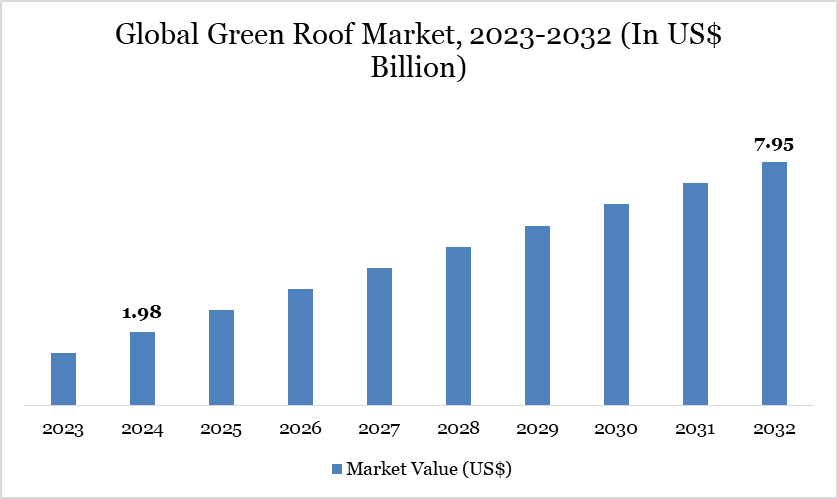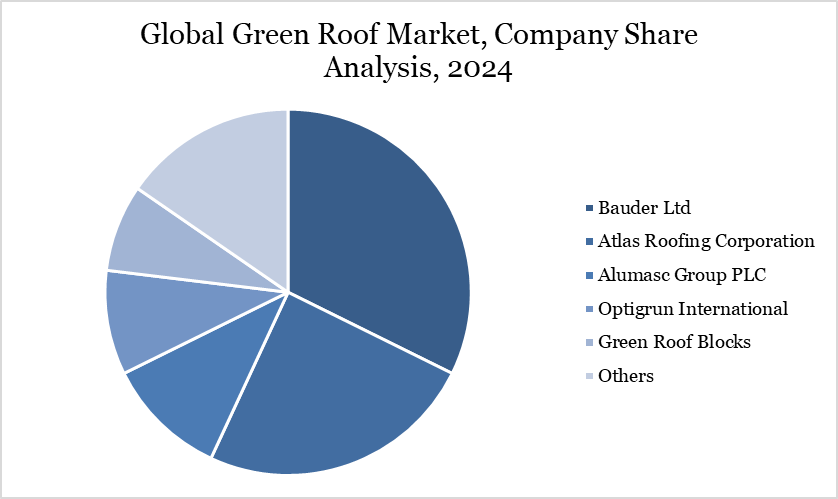Green Roof Market Overview
Global Green Roof Market reached US$ 1.98 billion in 2024 and is expected to reach US$ 7.95 billion by 2032, growing with a CAGR of 18.98% during the forecast period 2025-2032.
The green roof industry is experiencing significant expansion due to rising urbanization, climate resilience efforts, and the worldwide movement towards sustainable infrastructure. Green roofs, known as living roofs or eco-roofs, are vegetative layers placed on buildings that provide ecological, economic, and aesthetic advantages. They function as efficient insulating systems, regulate stormwater runoff, and lower ambient urban temperatures, rendering them increasingly pertinent in climate-vulnerable cities.
As urban growth and industrialization diminish green spaces, green roofs are increasingly recognized as a possible solution to mitigate cementification. Governments are implementing incentives, such as diminished stormwater management fees, to promote adoption. Both commercial and residential sectors acknowledge the enduring benefits of green roofing in improving building performance and visual attractiveness. As cities worldwide adopt net-zero carbon strategies, green roofs are increasingly integral to climate action plans and smart city frameworks, harmonizing policy and design for a more sustainable built environment.
Green Roof Market Trend
Recent trends indicate a transition towards multifunctional and technologically integrated green roofs. Innovations encompass the integration of green roofing systems with photovoltaics, yielding mutual advantages vegetation cools the panels, enhancing energy output, while the panels support plant diversity and growth. This tendency signifies a wider transition towards multifunctional infrastructure in urban sustainability.
Companies like as Chatfield Green Roofing are broadening their product offerings to incorporate vital green roof elements, addressing the increasing demand for flexible and versatile solutions. Furthermore, the utilization of locally sourced, inexpensive waste products is increasingly prevalent. Scientific research has confirmed that substrates like biochar derived from agricultural waste and coconut shell fibers improve performance and minimize runoff more efficiently than traditional materials. These innovations substantially decrease initial installation expenses while enhancing long-term hydrothermal efficiency. As environmental regulations intensify and architectural aesthetics gain prominence, green roofs are transitioning from optional enhancements to fundamental components of urban development.

For more details on this report – Request for Sample
Market Scope
| Metrics | Details |
| By Type | Extensive, Intensive |
| By Application | Residential, Commercial, Industrial |
| By Region | North America, South America, Europe, Asia-Pacific, Middle East and Africa |
| Report Insights Covered | Competitive Landscape Analysis, Company Profile Analysis, Market Size, Share, Growth |
Green Roof Market Dynamics
Policy, Space, and Profit – the Triad Driving Green Roof Proliferation
The intersection of public policies, spatial limitations, and market-driven value generation is advancing the green roof sector. Urban densification has resulted in spatial scarcity, positioning rooftops as the new frontier for environmental intervention. These versatile rooftops serve as agricultural areas, social spaces, and urban cooling zones, transforming underutilized infrastructure into valuable assets.
Regulatory incentives are further promoting adoption; for instance, Washington, DC, provides property owners with lower stormwater fees for green roofs. Moreover, national and local policies associated with net-zero objectives advocate for green infrastructure as a fundamental component of climate adaptation. Commercially, buildings featuring green roofs have shown enhanced property prices and consumer attractiveness.
The collaboration between Azizi Developments and Soprema Inc. in October 2024 highlights the industry's dedication to enhancing roof waterproofing solutions that promote vegetation. These drivers collectively establish a robust basis for green roofing to evolve from a niche solution to a regular practice in urban environments.
Substantial Initial Investment and Technical Complexity Hinder Early Adoption
Substantial initial installation expenses continue to pose a significant obstacle to the adoption of green roofs, especially in price-sensitive markets. Intricate technical specifications, waterproofing systems, and structural load evaluations can substantially elevate initial project costs. Although governmental incentives alleviate certain financial pressures, costs continue to dissuade smaller developers and households.
Green roofs necessitate specific expertise for installation and upkeep, hence increasing labor and operational costs. Technical obstacles continue to exist in optimizing substrate composition, selecting plants, and implementing drainage solutions, especially in varied climatic circumstances. Despite developments such as the incorporation of recycled materials (e.g., coconut shell filters) providing economical alternatives, comprehensive awareness and shown scalability remain in progress. The absence of defined norms and accessible funding choices may hinder the proliferation of green roofing systems in emerging nations, hence constraining their efficacy as a universal climate adaption method.
Green Roof Market Segment Analysis
The global green roof market is segmented based on type, application, and region.

Green Roofs Transforming Urban Residential Living
In the residential sector, green roofs provide various valuable functions such as thermal insulation, rooftop horticulture, rainwater management, and aesthetic improvement. As urban dwellers become more environmentally concerned, eco-roofs have emerged as a favored choice for sustainable living. Rooftop gardens are especially favored for individual food cultivation, providing both economic and health advantages in highly populated regions.
The thermal insulation characteristics of green roofs provide substantial energy savings up to 10% relative to conventional roofs rendering them economically advantageous in the long term. These advantages not only augment internal comfort but also elevate the building’s overall market worth. Urban inhabitants are increasingly drawn to green roofs due to its aesthetic allure and the opportunity to connect with nature amidst concrete-heavy environments. Facilitated by smart city initiatives, green roofing is becoming essential in residential building aimed at enhancing citizen well-being, environmental efficacy, and contemporary lifestyle needs.
Green Roof Market Geographical Share
Urban Regulations and Incentives Propel North America Green Roof Market
North America, especially the US, is becoming a leader in green roof implementation due to a combination of regulatory backing, metropolitan density, and environmentally aware construction practices. Urban areas such as Washington, DC, have formalized incentives, including reductions in stormwater management fees, that substantially motivate property owners to implement green roofing systems.
The integration of green infrastructure with overarching net-zero carbon objectives is a significant impetus for communities throughout the US and Canada. Moreover, the visual and economic allure of green roofs providing cooler interiors, less utility expenses, and enhanced property value is appealing to both homeowners and developers.
Recent market developments, including Chatfield Green Roofing's product line extension in April 2024, indicate heightened supply-side preparedness to address escalating demand. The North American green roof market, supported by robust governmental endorsement and an evolving supplier ecosystem, is poised for consistent expansion and the establishment of global standards in sustainable urban building.
Sustainability Analysis
Green roofing constitutes a crucial approach in promoting sustainable urban ecosystems. Serving as natural insulators, they diminish a building's energy use and carbon footprint. Research indicates that energy savings can attain up to 10% relative to traditional rooftops, significantly aiding urban climate mitigation efforts. In addition to energy efficiency, green roofs mitigate runoff and enhance air quality, providing comprehensive ecological advantages.
The incorporation of recycled resources, including biochar and coconut trash, in drainage systems reduces expenses and fosters circular construction methodologies. As urban areas strive for Smart City designation and adopt net-zero emission objectives, green roofs are increasingly recognized as multifunctional infrastructure.
Life cycle assessments and current scientific research highlight their enduring viability and economic efficiency. Green roofs facilitate a regenerative construction methodology that aligns human habitation with natural restoration, transforming urban development to emphasize resilience, beauty, and sustainability.
Green Roof Market Major Players
The major global players in the market include Bauder Ltd, Atlas Roofing Corporation, Alumasc Group PLC, Optigrun International, Green Roof Blocks, Soprema Inc., Axter Limited, American Hydrotech Inc., Archiegreen Zöldtető Kft, ZinCo GmbH.

Key Developments
In January 2025, Sempergreen showcased its latest advancements in green roof systems and living walls at the BAU Munich 2025 trade fair.
In February 2024, American Hydrotech (Sika), one of the companies in the waterproofing and roofing solutions industry, announced that its garden roof assemblies received certification from Factory Mutual (FM) Approvals.
Why Choose DataM?
Data-Driven Insights: Dive into detailed analyses with granular insights such as pricing, market shares and value chain evaluations, enriched by interviews with industry leaders and disruptors.
Post-Purchase Support and Expert Analyst Consultations: As a valued client, gain direct access to our expert analysts for personalized advice and strategic guidance, tailored to your specific needs and challenges.
White Papers and Case Studies: Benefit quarterly from our in-depth studies related to your purchased titles, tailored to refine your operational and marketing strategies for maximum impact.
Annual Updates on Purchased Reports: As an existing customer, enjoy the privilege of annual updates to your reports, ensuring you stay abreast of the latest market insights and technological advancements. Terms and conditions apply.
Specialized Focus on Emerging Markets: DataM differentiates itself by delivering in-depth, specialized insights specifically for emerging markets, rather than offering generalized geographic overviews. This approach equips our clients with a nuanced understanding and actionable intelligence that are essential for navigating and succeeding in high-growth regions.
Value of DataM Reports: Our reports offer specialized insights tailored to the latest trends and specific business inquiries. This personalized approach provides a deeper, strategic perspective, ensuring you receive the precise information necessary to make informed decisions. These insights complement and go beyond what is typically available in generic databases.
Target Audience 2024
Manufacturers/ Buyers
Industry Investors/Investment Bankers
Research Professionals
Emerging Companies